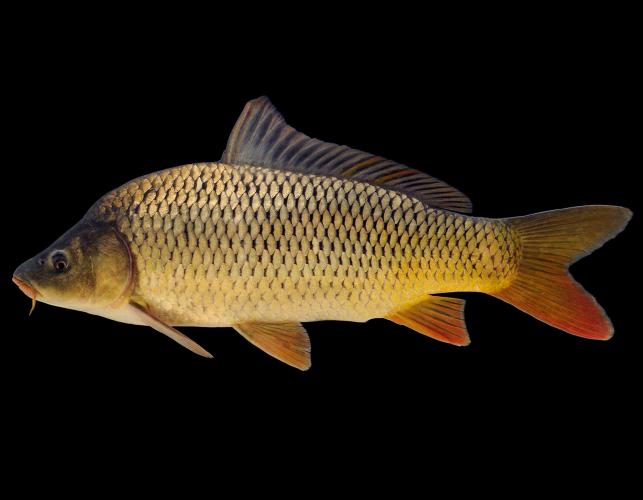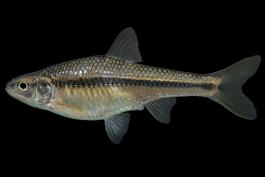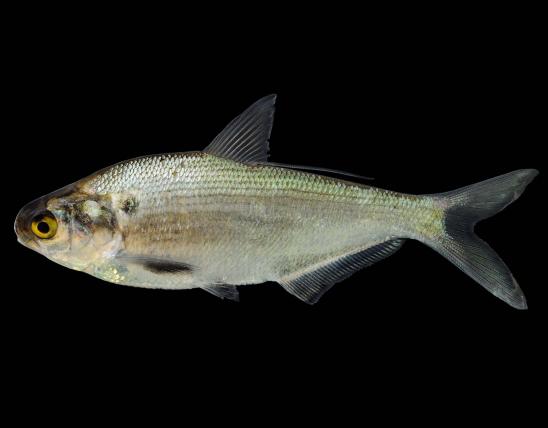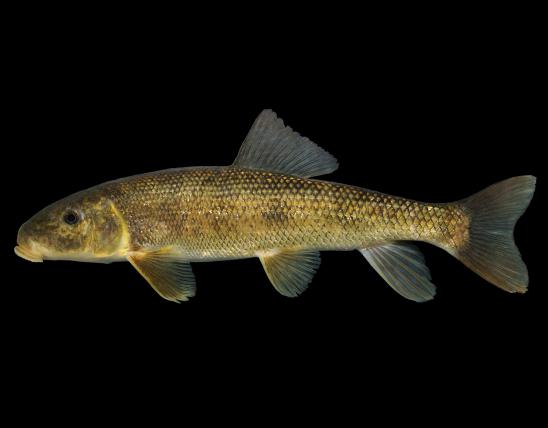
Although the term “minnow” is sometimes used loosely to refer to any small fish, it is properly used only in referring to the members of the minnow family, the Cyprinidae. It is the largest of all fish families.
Although many species are indeed small, some members of the minnow family grow to a considerable size. The Colorado pikeminnow, found in the western United States, can reach a length of 6 feet and weigh over 100 pounds. Here in Missouri, introduced carp species can reach 40 pounds or more. Among our native minnows, however, none exceed a length of 14 inches or a weight of 12 ounces.
Native Missouri minnows share the following combination of characters. You can use these to separate them from our other small fishes:
- The fins lack spines. There are 8 principal rays in the dorsal fin (9 in the pugnose minnow), and 16 or fewer principal rays in the anal fin.
- The body is covered with smooth-edged (cycloid) scales. The head lacks scales.
- The jaws lack teeth.
- There is no small, fleshy fin (adipose fin) on the back behind the dorsal fin.
Some nonnative, introduced members of the minnow family are also found in Missouri. Many of them have a crosshatched look to their scales. They differ from the above description by the following:
- Common carp and goldfish have 17 or more rays in the dorsal fin and a stout, saw-toothed spine at the front of the dorsal and anal fins.
- Bighead carp, silver carp, and rudd differ from all native minnows (except the golden shiner) in having a fleshy keel along the belly.
- Grass carp and black carp are distinguished by their larger adult size. Grass carp have prominent parallel grooves on the throat teeth. Black carp have large throat teeth that resemble human molars.
Globally, about 1,200–1,500 species of minnows are known to be alive on earth today, and they occur on every continent except South America and Australia. The family is well represented in Missouri. Nearly one-third of all our native fishes are minnows.
There are about 70 species of minnows recorded for Missouri. Some are widespread and occur in a variety of aquatic habitats, while others are restricted to certain stream systems — some of those are rare and endangered.
Missouri’s native minnows are in the following genera:
- Campostoma (2 spp. of stonerollers)
- Chrosomus (1 sp., the southern redbelly dace)
- Cyprinella (6 spp. of shiners)
- Erimystax (2 spp. of chubs)
- Hybognathus (5 spp. of minnows)
- Hybopsis (2 spp., formerly Notropis)
- Luxilus (5 spp. of shiners)
- Lythrurus (2 spp. of shiners)
- Macrhybopsis (4 spp. of chubs)
- Nocomis (2 spp. of chubs)
- Notemigonus (1 sp., the golden shiner)
- Notropis (22 spp. of shiners and minnows)
- Opsopoeodus (1 sp., the pugnose minnow)
- Phenacobius (1 sp., the suckermouth minnow)
- Pimephales (4 spp. of minnows)
- Platygobio (1 sp., the flathead chub)
- Semotilus (1 sp., the creek chub)
Nonnative members of the minnow family that may be found in Missouri:
- Carassius (1 sp., the goldfish)
- Ctenopharyngodon (1 sp., the grass carp)
- Cyprinus (1 sp., the common carp)
- Hypophthalmichthys (2 spp., the silver and bighead carps)
- Mylopharyngodon (1 sp., the black carp)
- Scardinius (1 sp., the European rudd)
Similar species: Our native minnows are most likely to be confused with the killifishes (topminnows and studfishes), the western mosquitofish, the silversides, and the young of suckers.
Adult length varies by species. One of our smallest minnows, the ghost shiner, rarely exceeds 2 inches. Our largest native minnow, the creek chub, can exceed 12 inches; usually it’s 5–7 inches. Nonnative carps can reach nearly 100 pounds.
Minnows occur statewide. Each species has its own particular habitat requirements, and few are distributed statewide. Those with similar habitat requirements tend to have similar distributions, and each section of the state, and each habitat, has its own characteristic minnows.
Habitat and Conservation
Minnows are found in nearly all the natural waters of the state that are not polluted or otherwise unsuited for fish life, but they are more characteristic of streams than of lakes or ponds. In streams they are often more numerous than all other fishes combined.
In Ozark streams, minnows, along with darters, are the dominant groups of small fishes. The geographic separation of the various stream systems has led to a great variety of uniquely different species. The common and widespread minnows in the Ozarks are the largescale stoneroller, central stoneroller, striped shiner, bleeding shiner, hornyhead chub, bigeye shiner, wedgespot shiner, Ozark minnow, rosyface shiner, southern redbelly dace, and bluntnose minnow. The whitetail shiner, steelcolor shiner, Ozark chub, cardinal shiner, duskystripe shiner, bigeye chub, silverjaw minnow, and telescope shiner are abundant in certain drainages.
In the Mississippi Lowlands of Missouri’s Bootheel, minnows are well represented but have fewer overall numbers than in the Ozarks. Common minnows in this region include blacktail shiner, ribbon shiner, ironcolor shiner, weed shiner, and bullhead minnow.
In the prairie (dissected till plains) region in the northern half of Missouri, minnows are the dominant group of small fishes. Common and characteristic species include the red shiner, redfin shiner, golden shiner, bigmouth shiner, sand shiner, suckermouth minnow, fathead minnow, and creek chub. Certain minnows are not widespread but are particularly characteristic of Missouri’s prairie region, including the brassy minnow, common shiner, ghost shiner, and Topeka shiner.
In Missouri’s big rivers (the Missouri and the Mississippi), minnows are the most abundant group of small fishes. Especially characteristic minnows include the speckled, sturgeon, sicklefin, silver, and flathead chubs; the plains minnow; and the emerald, river, silverband, and channel shiners.
In the Missouri River and downstream in the Mississippi River below the Missouri, the sicklefin chub, sturgeon chub, flathead chub, plains minnow, and western silvery minnow occur. They are not found in the Mississippi River above the mouth of the Missouri.
Common carp and other large nonnative carp are most common in our larger rivers and/or large reservoirs.
Food
The diet of each minnow species correlates to its structures for feeding. Carnivorous minnows, which eat insects and other invertebrates, fish, or other animals, typically have large mouths positioned at the tip of the snout and sharp, hooked throat teeth for capturing and holding their prey, which they often swallow whole. The short intestine of carnivorous minnows suffices for the rapid digestion of animal material. The lining of the body cavity (peritoneum) is usually silvery in carnivorous minnows.
Herbivorous (plant-eating) minnows often have small mouths positioned downwards and molarlike throat teeth for grinding up plant material before it is swallowed. Plant material is less readily digested than animal material, so most herbivorous minnows have very long, looping intestines. The lining of the body cavity is usually uniformly black in herbivorous minnows.
Status
Nearly 20 of Missouri’s native minnows are species of conservation concern, meaning that their presence in our state is to some degree imperiled:
- Five Missouri minnows are listed as endangered in the state of Missouri: cypress minnow, taillight shiner, Sabine shiner, flathead chub, and Topeka shiner. The Topeka shiner is also listed as endangered on the federal list.
- Thirteen other Missouri minnows are listed as species of conservation concern in Missouri, meaning that they are to some degree imperiled or vulnerable to extirpation from our state or to extinction: the sturgeon chub; the bluntface, ghost, ironcolor, blacknose, Ozark, and weed shiners; the western silvery, brassy, Mississippi silvery, plains, and pugnose minnows; and the eastern and western slim minnow (two subspecies).
- The pallid shiner, Hybopsis amnis, is presumed to be extirpated from our state. It used to be widespread in the eastern part of the state, especially in the lowland streams of southeast Missouri.
The five large Asian carps that may occur in Missouri waters are considered invasive: black carp, silver carp, bighead carp, grass carp, and common carp. Black, silver, and bighead carp are illegal to use as live bait. Do not collect, transfer, or dump these fish.
Life Cycle
Minnows, as a group, have an interesting diversity of reproductive behaviors and adaptations. The breeding males of many species are brightly colored and have small wartlike structures called breeding tubercles scattered over various parts of the head, body, and fins. The common names of some species, such as the bleeding shiner, redfin shiner, and hornyhead chub, refer to these features. The bright colors advertise the presence of the male to other individuals of his own species, and the tubercles are used for driving other males from his territory, in jostling for favored positions over the spawning site, or for clasping the female during the spawning embrace.
The hornyhead chub and creek chub spawn in pits dug by the male, who then laboriously fills the pits again with pebbles he carries in his mouth. Other minnows, such as the Ozark minnow and redfin shiner, spawn over the nests of their more ambitious relatives or even over the nest of fishes belonging to entirely different families. Still others deposit their eggs over vegetation, logs, or gravel, with little advance preparation of the spawning site.
Few minnows practice parental care, deserting the eggs once spawning is completed. The bluntnose and fathead minnows are exceptions: they attach their eggs to the underside of submerged objects, and the male remains with the eggs, cleaning and guarding them until they hatch.
Human Connections
The minnow family contains many good aquarium fishes. The southern redbelly dace, speckled chub, redfin shiner, ironcolor shiner, bigmouth shiner, red shiner, and bluntnose minnow are some native minnows that work well in aquaria. Some of these have beautiful breeding colors. Nongame fishes may be collected for aquarium purposes by the holder of a fishing permit, using techniques and in numbers specified in the Wildlife Code of Missouri. Make sure you identify the fishes correctly, since nearly 20 species are listed as species of conservation concern, which may limit or prohibit their possession (consult the current Wildlife Code of Missouri).
Few Missouri minnows are large enough to provide much in the way of food or fishing opportunities for people. The large, nonnative carp are obvious exceptions. The hornyhead chub and creek chub will rise readily to a fly or other small lure and provide some sport when taken on light tackle.
Small minnows are commonly used as bait fish.
For people, perhaps the greatest importance of minnows lies in their role in converting plants and aquatic invertebrates — the basic productivity of streams and lakes — into their own bodies, which become food for fish of more direct benefit to humans.
Aquatic wildlife, including the many small minnows that dart around in Missouri streams, is one of the reasons people enjoy going on float trips. Float trips contribute to Missouri’s economy and to people’s health and well-being.
People who keep tropical fish in aquariums are familiar with several members of the minnow family from other parts of the world, such as barbs (including the so-called bala shark), danios, rasboras, rainbow or redfin “sharks,” and the White Cloud Mountain minnow.
Aquarists and people who have fish ponds are familiar with goldfish and koi. For centuries, these two species of Asian minnows have been bred for bright colors and patterns, and were a way to show wealth and social affluence.
Some minnows are called “daces,” but what's a “dace”? It's a word that goes back to Middle English, where it became the name for a certain type of minnow, and then for just about any kind of small, darting minnow. It was derived from the word “dars,” which was the Old French word for “dart.”
It is possible to observe fishes in nature, and minnows can be fun to watch. Many species occur in clear, fairly shallow waters, and in spring, you can watch them during spawning season. Many minnows have brilliant colors and interesting behaviors during spawning season. If you are looking at them from above water, approach cautiously and avoid creating vibrations that may be transferred to the water. Consider using binoculars, or wear polarized sunglasses to reduce glare from the reflected sunlight. Choose days with little wind to break up the water’s surface.
The construction of large hydroelectric and flood control reservoirs in the last century has altered and destroyed stream habitat, leading to declines in many types of fishes, including some minnows. The presence of a dam, and an immense lake not inhabitable by stream-dwelling fishes, blocks waterways, preventing fishes from one side of the dam from recolonizing streams on the other side of it. So if a population in a small tributary stream is eliminated for some reason, there may be no way for that stream to become repopulated. Some of the minnows that have disappeared from certain stream systems due to this situation are the Ozark chub, bigeye chub, and Ozark shiner.
Other environmental changes that have caused declines are due to land management, such as timber cutting, construction, and agricultural practices that disturb soils and, through runoff, lead to increased siltation in streams. For fishes (like many of our Ozark minnows) that require clear-flowing streams with rocky or gravelly substrates, siltation is a major threat.
Ecosystem Connections
Minnows are an important middle link in aquatic food chains, eating plants, insects, or other small aquatic organisms, and then being eaten by larger animals — larger fishes, frogs, snakes, turtles, birds, and mammals. As with other animals, the eggs and young are most vulnerable to predation.
In spring, hornyhead chub nests are a center of activity for many other species of fish. Male hornyhead chub construct mound nests 1–3 feet in diameter, transporting stones with their mouths from as far away as 20 feet. Some of the rocks are larger than the chub’s own head. These rock mounds are easy to see in Ozark stream bottoms in May and early June. Several other species of minnows use chub nests for their spawning activities and are tolerated by the male chub. Frequently a swarm of brightly colored bleeding shiners, redbelly dace, and Ozark minnows may be seen over a nest while the male chub industriously transports pebbles, oblivious to the presence of these other fish. Other small minnows, darters, and sunfish also gather near the nest to eat eggs whenever the opportunity presents itself.
Redfin, red, and Topeka shiners have an intimate association with members of the sunfish family. They deposit their eggs over the nests of sunfishes such as the green, longear, and orangespotted sunfishes. The relationship with redfin shiners and green sunfish has been studied extensively. The shiners are attracted to the nest by the nest-building activities of the male sunfish, but they are stimulated to spawn by the scent of the milt and ovarian fluid of the spawning sunfish. There can be more than 100 male redfin shiners gathered at one time around sunfish nests. The sunfishes do not generally bother the shiners. The shiners benefit from having their eggs in the clean, silt-free sunfish nest and by the male sunfish chasing away egg-eating intruders.
Generally speaking, most animals where the males possess bright colors are species that have the ability to see color. Fish use color as a way to communicate their gender, their condition, and even their mood. Bright or shiny lines or spots might also help minnows maintain the correct distance in their schools, too, especially in dim light or murky water.
Schooling behavior is highly developed in members of the minnow family. A school is not merely a crowd of fish. It is a social grouping in which fish maintain a definite organization. Schooling fish commonly sort themselves out so that all individuals in a school are of about the same size. The individuals maintain a definite orientation to one another, and their movements are remarkably synchronized. They maintain a constant fish-to-fish distance. When they approach an obstruction or when a predator appears, all turn in unison and swim off in a new direction.
Surprisingly, a school of fish has no leader, and the manner in which this remarkable social organization is maintained has been a source of much speculation. Some have suggested that visual attraction of one individual for others of its kind keeps the school together and maintains the characteristic spacing. According to this idea, individuals are attracted and move toward each other until a certain distance is reached, but are repelled if they approach too closely. Probably the spacing adopted has to do with economy of effort — creating a minimum turbulence similar to slipstreaming of racing cars or geese flying in V formation. This would explain the usual uniformity of fish size as well as of spacing in fish schools, with actual spacing being size-dependent. Schooling undoubtedly has other advantages, similar to herding behavior in grazing mammals. Some studies have suggested that schooling promotes better growth and reduced mortality from predation and other factors.
The nonnative carp that occur in Missouri are detrimental to our native ecosystems:
- Common carp, long established here, are aggressive, active feeders that often uproot plants and stir up the water, making it more turbid. A group of them essentially alters the aquatic habitat.
- The grass carp was introduced to control vegetation, but it commonly removes too much vegetation and instead deteriorates the habitat for game fish; the populations and spread of grass carp have not yet stabilized, so the full effect is still unknown.
- The silver carp, a large, long-lived, efficient eater, has become abundant and competes with Missouri’s native plankton-eating fish, including paddlefish, bigmouth buffalo, and gizzard shad; it is very destructive to our native fisheries and to the balance of nature.
- The bighead carp was introduced to remove excessive nutrients in waste treatment and fertilized fish ponds but has become an aggressive nuisance, like the silver carp, outcompeting our native plankton-eating fish and serving no beneficial ecosystem purpose in our state.
- The black carp, originally introduced to control problematic snail populations in ponds of commercial fisheries, has proven that it’s able to reproduce here. It unbalances native aquatic ecosystems, making it worse for native species that are already troubled with pollution, siltation, and habitat loss or alteration. Its presence jeopardizes may critically endangered mollusk species.
The other nonnative minnows, the goldfish and the European rudd, fortunately, are not proving invasive in our state. They have been cultured as bait fish, and at times they have escaped and persisted in natural habitats.
If you’ve kept tropical fish in an aquarium, you’re probably familiar with a group of minnowlike fish called tetras. Tetras, pacus, and piranhas belong to a different family, the Characidae. While members of the minnow family (the Cyprinidae) are mostly all native to the northern hemisphere, characins and their relatives are almost all native to the southern hemisphere (Central and South America; recently, biologists separated some closely related African groups into different families). The cyprinids (minnows) and characins (tetras) are not closely related, but they share many characteristics in size and shape, schooling behaviors, ecosystem roles, and diversity. The minnows and the tetras are considered biological analogues. A similar parallel occurs with the northern hemisphere’s sunfish/bass family and the southern hemisphere’s cichlid family.

























































































